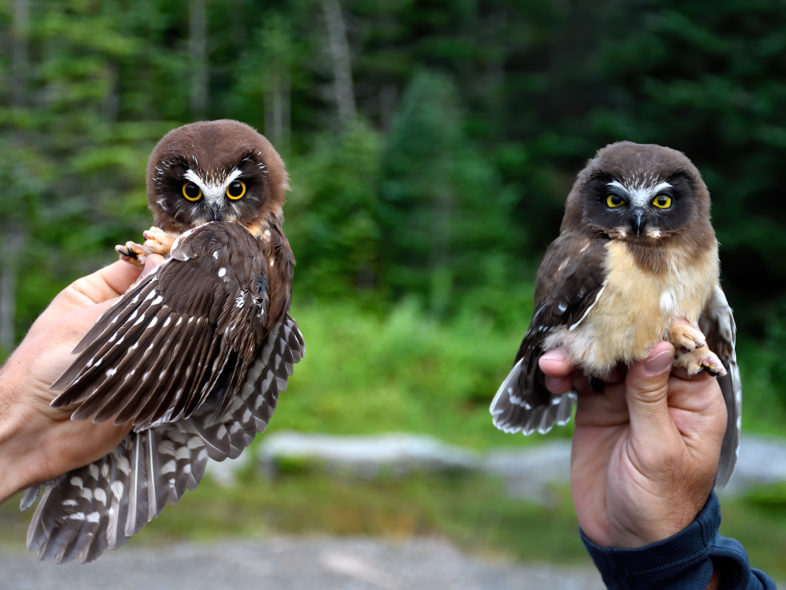
A duo of juvenile Northern Saw-what Owls captured in the same net (siblings?) just after dawn on Mt. Mansfield, 22 July 2020. © Michael Sargent
A distinct advantage of mid-summer’s dwindling daylength—at least for most of us humans—is dawn’s delayed arrival, and the opportunity to gain a bit more sleep. For VCE banders on Mt. Mansfield, still “trained” to rouse ourselves at 0400, that means opening nets in full darkness and hoping to intercept crepuscular breeders like Bicknell’s Thrush at first light. This past Wednesday, our abbreviated sleep schedule paid off with the side-by-side capture of two juvenile Northern Saw-whet Owls. Especially in its chocolate-brown juvenal plumage, this most diminutive of eastern North American owls epitomizes a term I try to avoid at all costs when describing birds—”cute”. It’s nearly impossible not to apply that descriptor when seeing a saw-whet (or two) up close and personal.
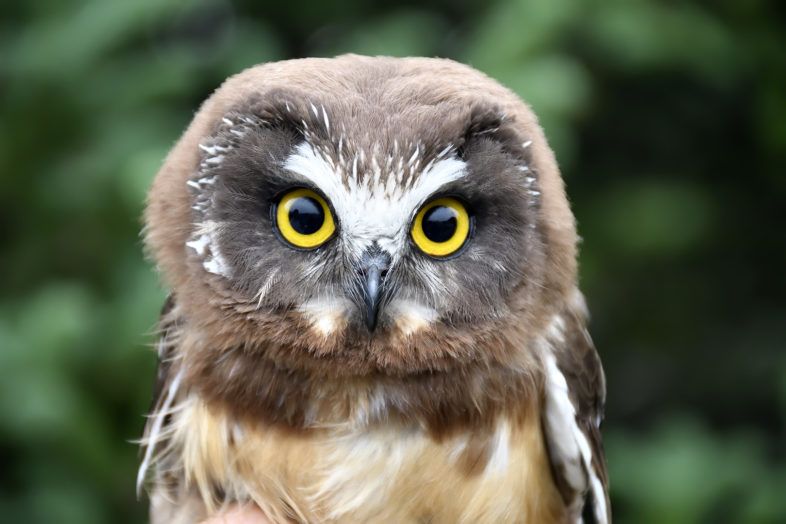
It’s impossible not to be captivated by a handheld juvenile Northern Saw-whet Owl. © Michael Sargent
We typically capture Northern Saw-whet Owls every other year, often during summers following bumper balsam fir cone crops. Strong “mast” years, such as 2019, when cones festooned fir trees across montane forests of the Northeast, tend to boost populations of small mammals like Red-backed Voles, which feed on the abundant seeds. Voles are a primary prey item for Northern Saw-whets, which in turn often respond by increasing their numbers, probably due to higher nesting success (i.e., more food for the kids). The generally biennial “boom or bust” cone crop cycle also affects populations of other vertebrates, such as Red Squirrels, White-winged Crossbills (we had a flock of 17 fly over on Wednesday morning), and Pine Siskins, all of which tend to increase after mast years and diminish following non-mast years. It’s a complex and fascinating ecological story, which even has consequences for open-cup nesting birds like Bicknell’s Thrush and Blackpoll Warbler, whose nests frequently fall victim to squirrel predation in summers following mast years (note: surprisingly, we have yet to see or hear a squirrel on the ridgeline this season).
Shifting to other species, our 2-day total of 40 individual captures was the lowest so far in 2020, but it featured a solid mix, including several non-local birds such as Brown Creeper, Song Sparrow, and Black-throated Blue Warbler. While our capture of only 2 Bicknell’s Thrushes was by far lower than in any other week so far, our season-to-date total of 34 individuals (20 new bandings, 14 returns from previous years; 23 males, 10 females, 1 fledgling) is on par with recent years. Blackpoll Warblers continued to put on a strong showing, as 7 new bandings bumped our 2020 total to an even 50 birds (33 on this date in 2019, 45 in 2018). Our capture of another 4 Yellow-bellied Flycatchers brought the season’s total to 12 birds, by far a station record.
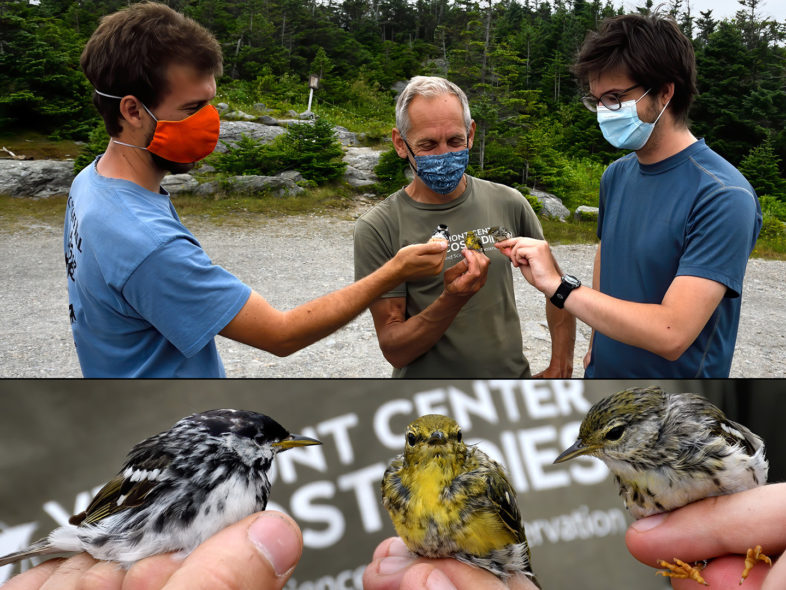
All in the family? Top: VCE banders Spencer Hardy (left), Chris Rimmer (center) and Sam Blair (right) display a trio of Blackpoll Warblers captured simultaneously from a single net. Bottom: from left, an adult male, a juvenile partway through its first prebasic molt, and an adult female. © Michael Sargent
Over both days, our capture total of 40 birds included:
Northern Saw-whet Owl — 2 juveniles captured in same net on dawn run
Yellow-bellied Flycatcher — 4 new adults (3 females with regressing brood patches, 1 unknown sex)
Black-capped Chickadee — 2 hatching-year birds
Red-breasted Nuthatch — 1 hatching-year male
Winter Wren — 1 hatching-year bird
Brown Creeper — 1 free-flying juvenile
Bicknell’s Thrush — 2 (return female from 2018 [missed in 2019]; within-season recapture of male originally banded in 2018)
Swainson’s Thrush — 1 within-season recapture of female with regressing brood patch
Dark-eyed Junco (Slate-colored) — 3 (2 free-flying juveniles, 1 new adult female with regressing brood patch)
White-throated Sparrow — 8 (3 new adult females, 1 new adult male, 4 free-flying juveniles)
Song Sparrow 1 free-flying juvenile; very unusual on reidgeline
Nashville Warbler — 1 hatching-year female
Blackpoll Warbler — 8 (5 new yearlings [2 males, 3 females], 2 free-flying juveniles, 1 within-season recapture)
Black-throated Blue Warbler — 1 yearling male in early primary molt
Yellow-rumped Warbler (Myrtle) — 3 new yearling birds (2 females, 1 male in early primary molt), 1 free-flying juvenile
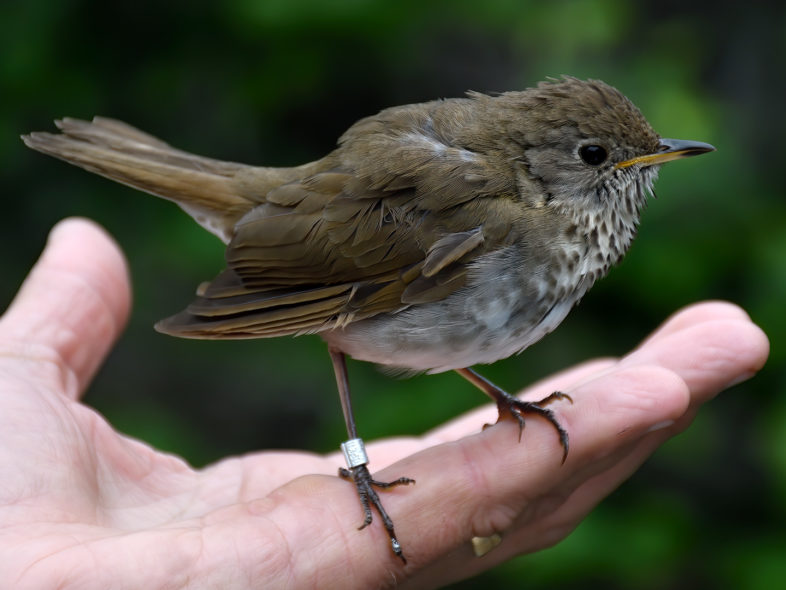
A recaptured male Bicknell’s Thrush, originally banded in 2018, lingers for a moment before beating it back to the montane forest. © Michael Sargent
As last week, many adults were in early stages of post-breeding flight feather molt, likely accounting in part for our lower number of captures. Molting birds tend to reduce their flight activity, due to the energetic and physical demands of growing new wing and tail feathers. Less flying translates to fewer mist net captures!
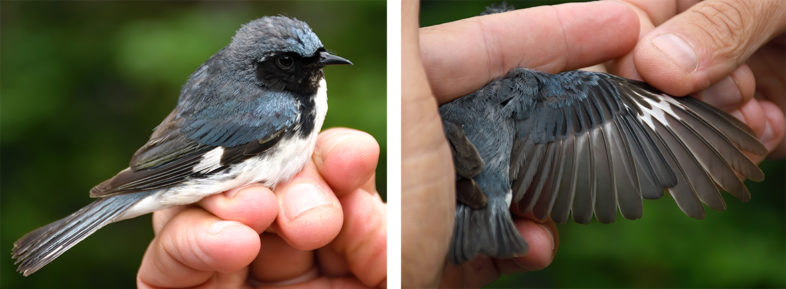
A yearling Black-throated Blue Warbler in early primary molt. Note that its innermost two primaries are 3/4 full-grown (appearing fresher and more distinctly blue), while the next primary #3 is missing. Primaries #4-9 have not het been shed. © Michael Sargent
Circling back to Northern Saw-whet Owls: our capture of two, very possibly sibling, juveniles was VCE’s first-ever “double” of this species. Although we’ve never had evidence that Saw-whets breed on Mansfield’s ridgeline, they probably nest at mid-elevations on the mountain, in transitional hardwood-conifer forest, where more large standing snags are available in which to find previously excavated cavities. These two juveniles were likely “local” in having fledged somewhere nearby, dispersing upslope after becoming independent from their parents. We don’t expect to encounter them again, but perhaps the North Branch Nature Center or another of Project Owlnet’s >150 banding sites will recapture one (or both) during their upcoming southward migration.
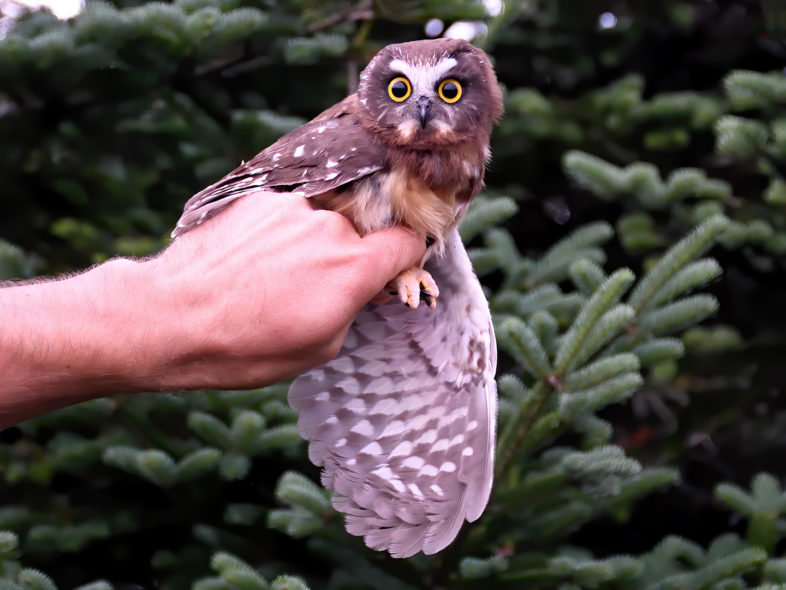
One of two banded juvenile Northern Saw-whet Owls ready for release on Mt. Mansfield, 22 July 2020. © Michael Sargent

Was there a distinct size difference between the juvenile saw-whet owls? Can U tell the of the owls at this age?
Fabulous photos and storytelling! Thank you.
Thank you, Ruth. Mike Sargent’s photos tell the story far more eloquently than my words ever could. Only size (mainly wing chord) can be used to separate male from female N. Saw-whets at any age. There are some published data on this, but these are considered by some authors to be unreliable and subject to unacceptable inaccuracies. Here is one paper on the subject: https://sora.unm.edu/sites/default/files/journals/jfo/v061n03/p0339-p0346.pdf. The current most-accepted sex determination criteria by Project Owlnet http://www.projectowlnet.org/?page_id=401 involve combining wing chord and mass (weight). Unfortunately, we were not able to weigh our two birds (defective scale for birds >50 g!), which had wing chords of 135.5 and 142.0 mm. These are on the high end of the scale, so suggest female, but we can’t be sure, so will report them to the Bird Banding Lab as sex U!
Loved the three Blackpoll Warblers! No way that I could have identified the juvenile out of context. If I had seen that bird alone on Ward Hill I would have been stumped!